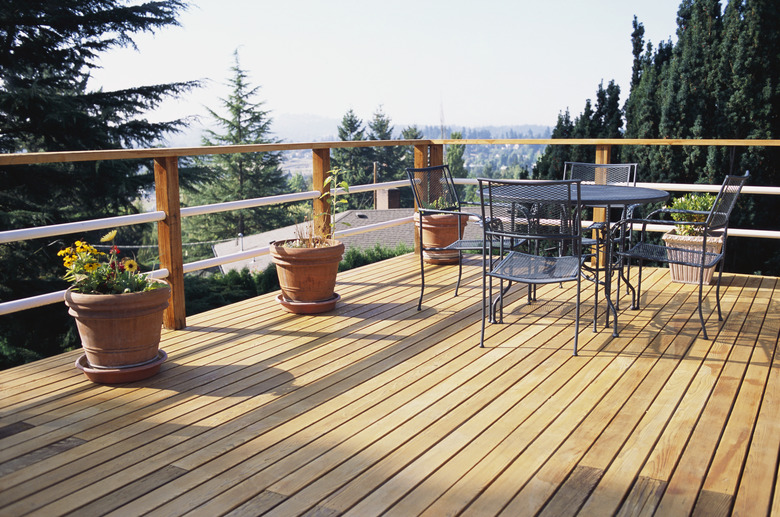My Deck Is Too Slippery In The Winter
We may receive a commission on purchases made from links.
Slippery decks can be a hazard at any time of year, but winter weather can aggravate an already dangerous situation. Often the stairs leading up to a deck provide an emergency entrance and exit to the home and must be kept accessible for safety reasons. Homes that have been subdivided into apartments often use a deck for sole and separate tenant access. Whatever the situation, safe footing on a deck and the stairs leading to or from it is highly essential.
Tip
To make your deck less slippery, clean the surface in the fall, remove snow promptly, add anti-skid strips to steps and coat the deck surface with anti-slip coating.
Deck Surface Issues
Deck Surface Issues
A winter deck may become slick as a result of precipitation that has not been adequately swept from the surface. All decks should have a slight slope to allow for moisture runoff and must be kept clear of ice and snow. Autumn is a good time to thoroughly sweep or power wash your deck to remove any dirt, debris or algae that can turn a winter rain or snowstorm into an accident just waiting to happen.
Winter Deck Maintenance
Winter Deck Maintenance
Keeping your deck cleared of snow will allow the sun to melt underlying ice and allow the melted snow to run safely through the spaces between your deck boards or be pulled harmlessly by gravity to the ground below. Use plastic shovels instead of metal shovels to protect the wood, and shovel with the boards instead of across the boards to keep from damaging the wood.
Using salt to melt snow and ice on a deck is not an advisable practice as it can damage your decking material and negatively impact the vegetation planted nearby. Look for salt-free products that provide an environmentally safe way to gain safe winter footing in icy conditions. Avoid chopping at the ice with a shovel or other tools.
Slippery Stairway Solution
Slippery Stairway Solution
The ease with which a homeowner or tenant can slip on a slippery set of deck stairs necessitates special care. A hardware store or your local home center is a good place to look for self-adhesive, non-slip traction treads that you can easily install yourself on the stairs of your deck. You can find it in precut sections or tape that you can cut to length. Choose a product that's designed for outdoor use, so it can hold up to extreme temperatures and weather elements. A nasty fall may be easily prevented by applying two or three strips of the peel-and-stick product parallel to the leading edge of each stair tread.
Anti-Slip Wood Coating
Anti-Slip Wood Coating
For larger surfaces like the deck flooring, there is an anti-slip coating that you can apply to the wood. This substance has an acrylic-based formula that allows surface water evaporation while impeding the damaging effects of moisture penetration into the wooden surface. The coating dries in three to five hours between coats and your deck is ready for next-day use. The sealant may be safely applied over paint and stain to form a safe, slip-free base to help guard against adverse winter weather conditions. Make sure you clean the deck well before applying the sealant.
You can also make your own anti-slip coating by mixing additives to latex porch and floor enamel. An easy option is coarse sand at a ratio of four parts paint to one part sand. Mix the paint and sand well, then, apply it like you would normal paint. You can also buy non-skid additives designed to go into floor paint. Follow the package instructions for proper mixing with your paint.
